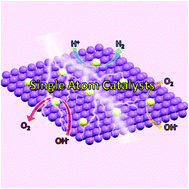Highly efficient, stable and cost-effective electrocatalysts for the hydrogen evolution reaction (HER), oxygen evolution reaction (OER), and oxygen reduction reaction (ORR) have been pursued for several decades. Herein, by employing density functional theory (DFT), a wide range of transition metal (TM = Sc, Ti, V, Cr, Mn, Fe, Co, Ni, Cu, Zn, Ru, Rh, Pd, Ag, Cd, Ir, Pt and Au) atoms anchored on antimonene (Sb monolayer) with a single Sb vacancy as single-atom catalysts (SACs) were investigated for their HER, OER and ORR performance. The results indicate that the defective Sb monolayer can be stable. Some TM@Sb monolayers show excellent stability and good electrical conductivity, beneficial for electron transfer during electrocatalytic reactions. The Ir@ and Pt@Sb monolayers exhibit excellent HER performance, both with about −0.01 eV of ΔG*H. The d band centre of the TM@Sb monolayer can be used to describe the binding strength between substrates and intermediates directly. The best OER electrocatalyst is the Pt@Sb monolayer, which shows an overpotential (ηOER) of 0.48 V. In contrast, the best ORR electrocatalyst is the Ag@Sb monolayer with an ηORR of 0.50 V, followed by Pd@, Rh@, Cd@ and Pt@Sb monolayers. Compared with pristine antimonene, only the noble metal atom could improve its OER and ORR performance effectively, and the Pt@Sb monolayer can be a trifunctional electrocatalyst for the HER/OER/ORR. Therefore, our calculations highlight a new type of SAC based on antimonene, which can be useful for energy conversion and storage.
